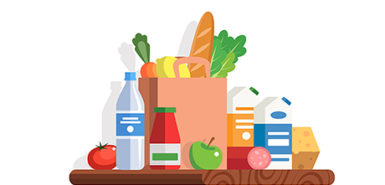
Carbohydrates get a bad rap these days, as they’re named Public Enemy No. 1 by devotees of diets such as keto, paleo and Atkins.
And that’s sent many confusing messages to people, especially those watching their weight and their metabolic health—or both.
That’s too bad.
“We need carbohydrates,” said Michelle Telemaque, RD, a registered dietitian and diabetes educator at Corewell Health. “They give us the energy required to function well and get through the days.”
Carbs are starches, sugars and fibers found in a wide array of foods, such as bread, potatoes, beans, rice, fruit, milk, candy, cookies and more.
As with many lifestyle choices, the problem is that many people struggle to moderate their carb intake.
Typically, for men, the right amount is under 60 grams of carbs per meal. For women, the recommendation is under 45 grams per meal.
That may sound like a lot, but consider that a slice of pizza and a soda is more than 70 grams. Cheeseburgers weigh in at 33 grams of carbs, and fries at 50 grams of carbs.
A trip to your favorite Italian restaurant is more problematic: A standard restaurant portion of spaghetti with meat sauce has 90 grams of carbs. For those breadsticks, add another 25 grams.
Sugar-spike roller coaster
Too many carbs can send blood-glucose levels too high, too fast. For people with diabetes, that can create a dangerous health situation. Learning to count carbs and consistently manage them over each meal and throughout the day is essential to good health.
But we could all benefit from becoming a little more carb-conscious, Telemaque said.
Those glucose spikes, and the inevitable crashes, aren’t good for anyone.
For those looking to shed some weight, it’s even more important to understand the role carbs play in a healthy eating plan.
Telemaque suggested a simple visual rule for most meals: “Make sure half your plate is filled with vegetables, and a quarter with lean protein. And eat those first.
“Then, if you want other foods, move on to the carbs when you’re not as hungry.”
Next, she said, read labels carefully. While some bread products may have 15 grams of carbs, some can double and some can have half the carbs.
“You want to look at the total grams of carbs, not the net carb value so many companies use in labeling,” she said.
Companies calculate net carbs by subtracting the grams of fiber they add to products from the total carb count. It is a standard marketing language in many keto-based labeling tactics.
Villainizing carbs or following too rigid of an eating program often isn’t sustainable. And it just isn’t necessary. It’s more a matter of renegotiating their role in your diet.
Some of Telemaque’s favorite approaches:
Change the bun
The typical sandwich bun has about 30 grams of carbs. Same with two pieces of bread. Wraps, tortillas, pitas and crackers can add just as much.
But many newer products have substantially fewer carbs, usually achieved by adding lots of fiber—and some are delicious.
Telemaque especially likes low-carb tortillas for wraps or burritos.
“The more fiber in the bread product, the better,” she said. “These foods are less likely to cause glucose levels to spike and fill you up.”
Skip the bun, now and then
Consider building a sandwich differently, perhaps using romaine or other lettuces to make roll-up sandwiches. Try a low-carb tortilla, flat bread or an open-faced sandwich.
Add flavor in freebies
Many vegetables add a lot of flavor and crunch for very little in carbs or calories. If you have that sandwich or burger, add fiber with vegetables, too. Think pickles, lettuce, tomato and onion slices.
“Fiber matters and it would be good if we could all add a few more grams to each meal,” Telemaque said.
Women should aim for 25 grams of fiber each day. For men, it’s closer to 40 grams.
Explore other grains
Oatmeal, barley, quinoa and other grains are not only delicious but also high in fiber, and can bost heart health. Besides counting as a carb serving, they bring many different textures and nutrients to the party.
Know your goals
Diets like keto, Atkins and paleo may promise quick results, which is a tempting approach for many of us, including those who may be overweight. And weight management is important.
“It’s because of that extra weight that we’re not using our insulin correctly or efficiently,” Telemaque said.
But often, some diets add lots of fat to compensate for too few carbs, increasing calories and raising the risk of heart disease and stroke, she said.
The carb-exercise connection
Exercise helps with many things, from stress management to sleep. But it also plays a crucial role in metabolic health.
People with diabetes who exercise at least 150 minutes a week have better control of glucose levels than less active people, even if they don’t lose weight.
Activity lowers blood glucose levels and boosts sensitivity to insulin, countering insulin resistance. For people looking to shed pounds, exercise can help.
“To lose 1 pound a week, people have to be in a calorie deficit of 500 calories a day,” Telemaque said. For many, eating at least 250 fewer calories and adding activity that burns 250 calories is enough to make a difference.
And in this case, she said, it may be best to ignore what your weight-loss app tells you. You probably didn’t earn an extra 500 calories from your morning workout.
Update your outlook
Often, people cling to a way of eating because they’ve always done it.
“I’ll talk to people who say, ‘I’ve been eating the same food item for lunch my whole life,'” Telemaque said.
But bodies change over time. What worked for people in their 20s and 30s is different than their 40s, 50s and 60s.
“It may be that what feels good in your 50s or 60s, both in terms of what you eat and how you exercise, is completely different than in your younger years,” Telemaque said.
“There are many different ways to be successful related to eating and exercise,” she said. “You need to define what works for you at your current stage of life.”
 /a>
/a>
 /a>
/a>
 /a>
/a>